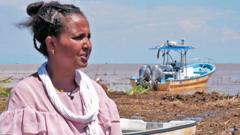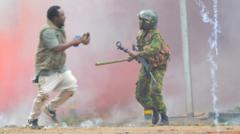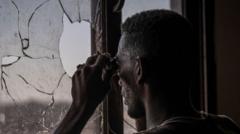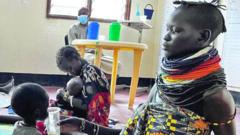Senait Mebrehtu, an Eritrean mother who fled oppression, finds herself grappling with the tragic loss of her daughter Hiyab, who drowned during a perilous journey. The ominous tale of smuggling through Lake Turkana highlights the desperate measures families take in the face of ongoing conflicts and national service conscription in Eritrea.
**Tragic Reminders of Smuggling Perils: A Mother's Grief at Lake Turkana**

**Tragic Reminders of Smuggling Perils: A Mother's Grief at Lake Turkana**
As a mother mourns her daughter lost to migrant smugglers, a harsh reality unfolds along Kenya's Lake Turkana, illustrating the dangers faced by many seeking a better life.
As the sun dipped below Lake Turkana, Senait Mebrehtu knelt by the water's edge, throwing flowers into the lake in memory of her teenage daughter Hiyab, who tragically drowned while attempting to reach Kenya. Last year, the 14-year-old's journey ended in disaster, overshadowed by the perils associated with illegal trafficking by smugglers.
Hiyab had ventured with her sister, who survived the treacherous crossing over the vast lake known for its unpredictable winds. "If the smugglers had informed me about the dangers of this lake, I would've never allowed my daughters to go," Senait lamented. A former Pentecostal Christian seeking asylum, Senait arrived in Nairobi on a tourist visa three years ago, bringing her two younger children and leaving her older daughters behind due to military conscription concerns prevalent in Eritrea.
Subsequently, with encouragement from relatives, she sought to smuggle her daughters out of Eritrea. Their journey involved weeks of travel marked by treks through Northern Ethiopia before reaching Kenya's shores.
An anonymous female smuggler confirmed to the BBC that routes like Lake Turkana are increasingly exploited due to heightened police presence in other areas. With extensive experience in this underground network, she operates throughout East Africa, charging hefty fees for each migrant she transports.
"The rise of what we call the 'digital route' illustrates a new wave of migration methods," she explained, acknowledging the significant risks involved, including dangerous boat journeys. Although these smugglers assure families that their loved ones will be safe, tragic stories often emerge.
Osman, an Eritrean migrant who witnessed Hiyab's boat capsizing, recalled the horror of that fateful night. He described how the small vessel struggled against overpowering winds before overturning 300 meters from shore, claiming seven lives, including Hiyab's. Her sister barely survived, clinging desperately to the wreckage until another boat arrived.
Senait holds the smugglers responsible, asserting that their negligence, which included overcrowding the vessel, directly contributed to the loss of life. In Lomekwi, locals reported seeing several bodies of migrants believed to be Eritreans in the water.
With an estimated 345,000 Eritrean refugees in East Africa, many, like Senait, flee due to oppressive military conscription and ongoing conflict. The shifting dynamics, including strife from neighboring Ethiopia and Sudan, have made countries like Kenya and Uganda increasingly appealing to these migrants.
Despite the inherent dangers, the smuggling network persists, facilitating continued journeys for many—sometimes leading as far as Europe or North America, with agents at every turn. Conditions in shelters for these migrants can be grim, with reports of starvation and abuse prevalent.
Senait embodies the collective pain shared among many families, still grieving their losses while finding solace in the survival of her other daughter. “May God heal our land and deliver us from all this,” she said, encapsulating both the despair and hope felt by countless Eritrean families entangled in this ongoing tragedy.





















